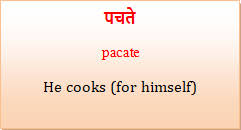Present tense verbs are the verbs that state the ongoing action. Here is the list of the present tense verbs:
हससि
Hassasi
You smile
तिष्ठामः
tiṣṭhāmaḥ
We stand.
These are some of the examples of present tense words in Sanskrit. Present tense verbs in Sanskrit convey more than one meaning.
Let’s take a look at how words form in present tense form
गच्छ gaccha (present tense)
Singular Dual Plural
Third person गच्छति
gacchati
गच्छन्ति
gacchanti
Second person गच्छसि
gacchasi
First person गच्छामि
gacchāmi
गच्छावः
gacchāvaḥ
गच्छामः
gacchāmaḥ
As you can see unlike English grammar table, in Sanskrit the table starts with the third person and going down to the first person. The table is of the verb गच्छ (gaccha) in present tense form. And as mentioned earlier, the root of the verb changes with the number of the subject. Every verb and in fact noun is presented in this format only.




